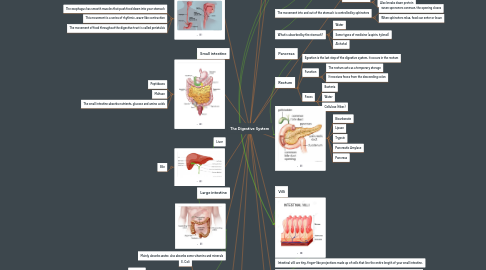The Digestive System
von Dania Abdelhadi


1. Organs are divided into 2 main groups
1.1. Alimentary canal
1.1.1. Performs all the digestive system functions
1.2. Accessory organs
1.2.1. The accessory organs secrete or store substances that pass through ducts into the alimentary canal
1.3. Pancreas
2. .
3. .
4. Mouth
5. Ingestion occurs in the mouth
5.1. The first step of digestion is physical
5.2. It involves breaking down food using your teeth
5.3. Chewing food activates the salivary glands
6. The salivary glands secrete saliva which contains
6.1. Water
6.2. Mucus
6.3. Amylase
7. Esophagus
8. .
8.1. The esophagus has smooth muscles that push food down into your stomach
8.2. This movement is a series of rhythmic, wave-like contraction
8.3. The movement of food throughout the digestive tract is called peristalsis
9. .
9.1. Peptidases
9.2. Maltase
9.3. The small intestine absorbs nutrients, glucose and amino acids
10. Small intestine
11. Liver
12. .
12.1. Bile
13. Large intestine
14. .
15. Mainly absorbs water, also absorbs some vitamins and minerals
16. Helpful bacteria
16.1. E. Coli
16.2. Bacteria produce vitamins
16.2.1. Vitamin k
16.2.2. Folic acid
16.2.3. Biotin
16.3. Generate gases
16.3.1. Methane
16.3.2. Hydrogen sulfide
17. Absorb carbs and proteins
18. Function
18.1. Ingestion
18.2. Digestion
18.3. Absorption
18.4. Defecation
19. The hollow organs that make up the GI tract are:
19.1. Mouth
19.2. Esophagus
19.3. Stomach
19.4. Small intestine
19.4.1. Duodenum
19.4.2. Jejunum
19.4.3. Illeum
19.5. Large intestine
19.6. Anus
19.7. .
20. Pharynx
21. .
21.1. Pharynx is a two-way passage
21.2. It receives food from the mouth and air from the nose
21.3. Epiglottis is a flap of cartilage and its function is to seal off the windpipe during eating, so that food is not accidentally inhaled
22. Stomach
23. .
24. The movement into and out of the stomach is controlled by sphincters
24.1. When sphincters contract, the opening closes
24.2. When sphincters relax, food can enter or leave
25. The stomach produces 3 main substances
25.1. Mucus
25.1.1. Protects the stomach from the hydrochloric acid
25.2. Pepsin
25.2.1. Digests protein
25.3. Hydrochloric acid
25.3.1. Lowers the ph of the stomach so pepsin can work
25.3.2. Also breaks down protein
26. What is absorbed by the stomach?
26.1. Water
26.2. Some types of medicine (aspirin, tylenol)
26.3. Alchohol
27. .
27.1. Bicarbonate
27.2. Lipase
27.3. Trypsin
27.4. Pancreatic Amylase
27.5. Pancreas
28. Pancreas
29. Villi
30. .
31. Villi are connected to your circulatory system through capillaries and your lymphatic system through lacteals
32. Intestinal villi are tiny, finger-like projections made up of cells that line the entire length of your small intestine.
33. Capillaries
34. Lacteals
34.1. Absorb fats then transport them into your circulatory system
35. Rectum
35.1. Egestion is the last step of the digestive system, it occurs in the rectum
35.2. Function
35.2.1. The rectum acts as a temporary storage
35.2.2. It receives feces from the descending colon
35.3. Feces
35.3.1. Bacteria
35.3.2. Water
35.3.3. Cellulose (fiber)
